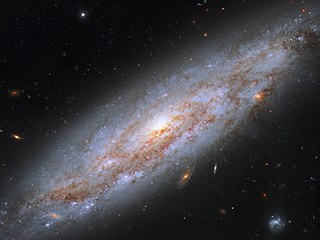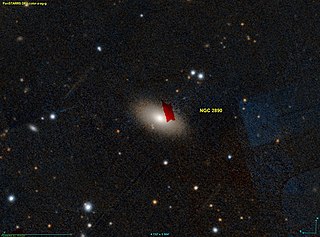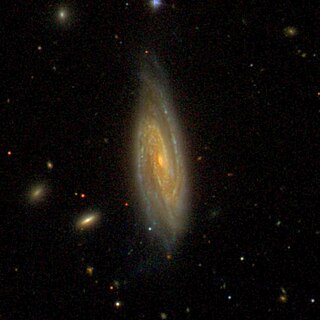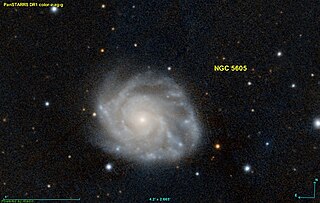
NGC 3184, the Little Pinwheel Galaxy, is a spiral galaxy approximately 40 million light-years away in the constellation Ursa Major. Its name comes from its resemblance to the Pinwheel Galaxy. It was discovered on 18 March 1787 by German-British astronomer William Herschel. It has two HII regions named NGC 3180 and NGC 3181.

NGC 1090 is a barred spiral galaxy located in the constellation Cetus.

Arp 271 is a pair of similarly sized interacting spiral galaxies, NGC 5426 and NGC 5427, in the constellation of Virgo. It is not certain whether the galaxies are going to eventually collide or not. They will continue interacting for tens of millions of years, creating new stars as a result of the mutual gravitational attraction between the galaxies, a pull seen in the bridge of stars already connecting the two. Located about 130 million light-years away, the Arp 271 pair is about 130,000 light-years across. It was originally discovered in 1785 by William Herschel. It is speculated, that the Milky Way will undergo a similar collision in about five billion years with the neighbouring Andromeda Galaxy, which is currently located about 2.6 million light-years away.

NGC 6181 is a barred spiral galaxy located in the constellation Hercules. It is designated as SB(rs)c in the galaxy morphological classification scheme and was discovered by William Herschel on 28 April 1788. The galaxy is 107 million light years away.

NGC 3972 is a spiral galaxy located in the northern constellation of Ursa Major. It was discovered by William Herschel on April 14, 1789. This galaxy is located 66 million light years away and is receding with a heliocentric radial velocity of 846 km/s. It is a member of the NGC 3992 Group of galaxies.

NGC 4774, also known as the Kidney Bean Galaxy, is a ring galaxy in the constellation of Canes Venatici. Its velocity with respect to the cosmic microwave background is 8581 ± 24 km/s, which corresponds to a Hubble distance of 126.56 ± 8.87 Mpc. It was discovered by German-British astronomer William Herschel on 17 March 1787.

NGC 7427 is a lenticular galaxy in the constellation of Pegasus. Its velocity with respect to the cosmic microwave background is 9336 ± 35 km/s, which corresponds to a Hubble distance of 137.70 ± 9.66 Mpc. It was discovered by Russian astronomer Otto Wilhelm von Struve on 22 November 1865.

NGC 2890 is a lenticular galaxy in the constellation of Hydra. Its velocity with respect to the cosmic microwave background is 5455 ± 37 km/s, which corresponds to a Hubble distance of 80.45 ± 5.67 Mpc. It was discovered by American astronomer Francis Leavenworth on 11 January 1886.

NGC 5936 is a barred spiral galaxy in the constellation of Serpens. Its velocity with respect to the cosmic microwave background is 4131 ± 11 km/s, which corresponds to a Hubble distance of 60.93 ± 4.27 Mpc. It was discovered by German-British astronomer William Herschel on 12 April 1784.

NGC 5784 is a lenticular galaxy in the constellation of Boötes. Its velocity with respect to the cosmic microwave background is 5493 ± 18 km/s, which corresponds to a Hubble distance of 81.01 ± 5.68 Mpc. It was discovered by German-British astronomer William Herschel on 9 April 1787.

NGC 5260 is a barred spiral galaxy in the constellation of Hydra. Its velocity with respect to the cosmic microwave background is 6789 ± 21 km/s, which corresponds to a Hubble distance of 100.13 ± 7.02 Mpc. It was discovered by American astronomer Lewis Swift on 6 April 1885.

NGC 2642 is a barred spiral galaxy in the constellation of Hydra. Its velocity with respect to the cosmic microwave background is 4632 ± 21 km/s, which corresponds to a Hubble distance of 68.32 ± 4.79 Mpc. It was discovered by British astronomer John Herschel on 19 February 1830.

NGC 5939 is a spiral galaxy in the constellation of Ursa Minor. Its velocity with respect to the cosmic microwave background is 6684 ± 4 km/s, which corresponds to a Hubble distance of 98.59 ± 6.90 Mpc. It was discovered by American astronomer Lewis Swift on 11 July 1883.

NGC 958 is a barred spiral galaxy in the constellation of Cetus. Its velocity with respect to the cosmic microwave background is 5505 ± 17 km/s, which corresponds to a Hubble distance of 81.20 ± 5.69 Mpc. However, 19 non-redshift measurements give a distance of 58.93 ± 12.91 Mpc. The galaxy was discovered by German-British astronomer William Herschel on 20 September 1784.

NGC 4375 is a barred spiral galaxy in the constellation of Coma Berenices. Its velocity with respect to the cosmic microwave background is 9325 ± 20 km/s, which corresponds to a Hubble distance of 137.54 ± 9.63 Mpc. However, four non-redshift measurements give a distance of 105.5 Mpc. The galaxy was discovered by German-British astronomer William Herschel on 11 April 1785.

NGC 3052 is an intermediate spiral galaxy in the constellation of Hydra. Its velocity with respect to the cosmic microwave background is 4122 ± 24 km/s, which corresponds to a Hubble distance of 60.79 ± 4.27 Mpc. However, 19 non redshift measurements give a much closer distance of 42.563 ± 6.434 Mpc. The galaxy was discovered by German-British astronomer William Herschel on 7 February 1785.

NGC 3362 is a intermediate spiral galaxy in the constellation of Leo. Its velocity with respect to the cosmic microwave background is 8676 ± 25 km/s, which corresponds to a Hubble distance of 127.97 ± 8.97 Mpc. However, three non redshift measurements give a distance of 95.8 ± 3.984 Mpc. The galaxy was discovered by German astronomer Albert Marth on 22 March 1865.

NGC 735 is a spiral galaxy in the constellation of Triangulum. Its velocity with respect to the cosmic microwave background is 4374 ± 18 km/s, which corresponds to a Hubble distance of 210.4 ± 14.7 Mly (64.52 ± 4.52 Mpc). In addition, eight non redshift measurements give a distance of 227.21 ± 7.99 Mly (69.662 ± 2.449 Mpc). The galaxy was discovered by German-British astronomer William Herschel on 13 September 1784).

NGC 5605 is an intermediate spiral galaxy in the constellation of Libra. Its velocity with respect to the cosmic microwave background is 3635 ± 18 km/s, which corresponds to a Hubble distance of 174.9 ± 12.3 Mly (53.61 ± 3.76 Mpc). In addition, three non redshift measurements give a distance of 194.72 ± 0.68 Mly (59.700 ± 0.208 Mpc). The galaxy was discovered by German-British astronomer William Herschel on 11 May 1784.

NGC 6492 is a spiral galaxy in the constellation of Pavo. Its velocity with respect to the cosmic microwave background is 4351 ± 8 km/s, which corresponds to a Hubble distance of 209.3 ± 14.6 Mly (64.17 ± 4.49 Mpc). In addition, five non redshift measurements give a distance of 183.10 ± 12.28 Mly (56.140 ± 3.766 Mpc). The galaxy was discovered by British astronomer John Herschel on 22 July 1835.




















